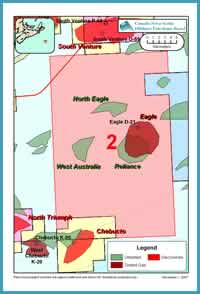
CANADA-NOVA SCOTIA OFFSHORE PETROLEUM BOARD


Geology
The Eagle gas reservoir is located within late Cretaceous limestones of the Wyandot formation, Figure 16. The reservoir is a thick, continuous package of limestones, marls and chalks representing deposition on a stable, shallow, open-marine continental shelf. Well data indicates that the Wyandot carbonates are generally lime mudstones that are soft, chalky, fossiliferous, pyritic, argillaceous and interbedded with marls and calcareous grey shales and mudstones. Seismic mapping, attribute analysis and the well data support the continuity of the Wyandot reservoir across the field.
The Eagle structure is a large faulted anticlinal feature which likely formed as a result of deep salt movement. The structure is bounded on the north and northwest by a major northeast-southwest trending growth fault. The Wyandot reservoir is trapped in a 3-way dip closure against the north bounding fault. The top seal is provided by the overlying shales of the Banquereau formation. The lateral extent of the reservoir to the east, south and southwest is likely limited by structure and the elevation of gas-water contact. However, due to the generally low matrix permeability of the reservoir it is possible that a stratigraphic component may also be limiting the pools lateral extent. The reservoir is trapped to the north and northwest against the north bounding fault. The bounding fault is interpreted as sealing, as the Wyandot reservoir is juxtaposed against shales and tight limestones of the Dawson Canyon formation on the north side of the fault.
In Eagle D-21, hydrocarbon generation from gas-prone source rocks was interpreted to begin between 1500 - 2400 m. The lower portion of the D-21 well, from 3660 - 4660 m (TD), is believed to have generated significant volumes of gas as this interval is at an early to moderate stage of maturity (Robertson Research, 1976). The gas generated from this interval likely migrated along fault planes until it was trapped in the Wyandot formation.
Robertson Research International Limited, Cooper B.S. et al, Report on a Geochemical Evaluation of the Eagle D-21 Well, Scotian Shelf, Offshore Eastern Canada, July 1976.
